Category: NYC History
Forgotten New York
After my days driving through the American Southwest, it was nice to be reminded of why I love this city. Tonight, the Gotham Gazette Book Club was meeting to discuss Kevin Walsh’s recently published Forgotten New York: Views of a Lost Metropolis — a written tour of the city’s “landmarks, quiet places, and oddities.” The author was present to give a brief presentation, joined by Roberta Gratz, author of Cities Back from the Edge: New Life for Downtown, and a commissioner on the city’s Landmarks Preservation Commission.
Walsh was contracted to write the book, based on the popularity of his website “Forgotten NY,” a compendium of “forgotten, overlooked, ancient sights in New York City” that he writes and designs himself. Walsh first began researching and taking photographs for his site in 1998, launching it in 1999 after he had compiled enough information for the first few dozen pages. Since then, he has kept up a fairly regular updating schedule — a new page of research, accompanied by period and contemporary photographs and maps about every other week — with the new material coming either from tours or his own research, gathered over meandering walks through the far corners of the city. Forgotten NY is by no means Manhattan-centric; Walsh was born in Brooklyn, raised in Bay Ridge, and currently resides in Flushing. He is a stocky, unassuming figure, and is quick to admit that he has no formal training in archival research or history. His site, and the book, rose organically from his own passion. From its humble beginnings — the design was and remains purely utilitarian — the site has amassed a devoted following; Walsh and Forgotten NY have been featured in Salon and on Gothamist.
Walsh seems to promote a different kind of New York City tourism: one that values the city not for its well-known and looming landmarks, but for everything else… the ephemeral trivia and detritus of urban living.
The event was being held, appropriately enough, at the Jefferson Market Branch of the New York Public Library – a site steeped in city history. The ornate Victorian Gothic building and clocktower were designed by architects Frederick Clark Withers and Calvert Vaux (who assisted Frederick Law Olmsted in the design of Central Park) and has been a fixture of the West Village since the 1870s, serving at times, as the site of a marketplace, a fire tower and a courthouse. (The adjacent jail was replaced by the New York Women’s House of Detention, which was demolished in 1974 to make way for a serene community garden. The Jefferson Market Greening was one of my favorite spots in the neighborhood when I was living on West 12th Street, predating the nuptials of Miranda and Steve on Sex and the City.)
The building where we sat that night was the center of national attention in 1906, when Harry K. Thaw was tried in the courthouse for murdering prominent architect and socialite Stanford White on the roof of Madison Square Garden – tagged by the newspapers as the “Girl in the Red Velvet Swing” trial. The notorious case was the loose basis of (Bronx Science alum) E. L. Doctorow’s novel, Ragtime, which was later adapted into a stage musical and a film.
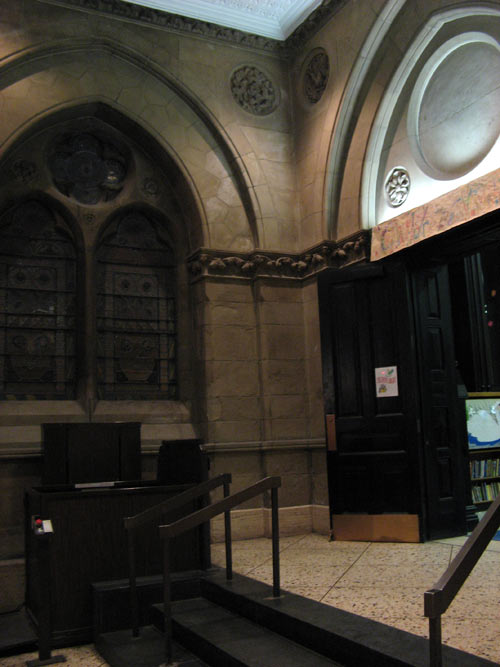
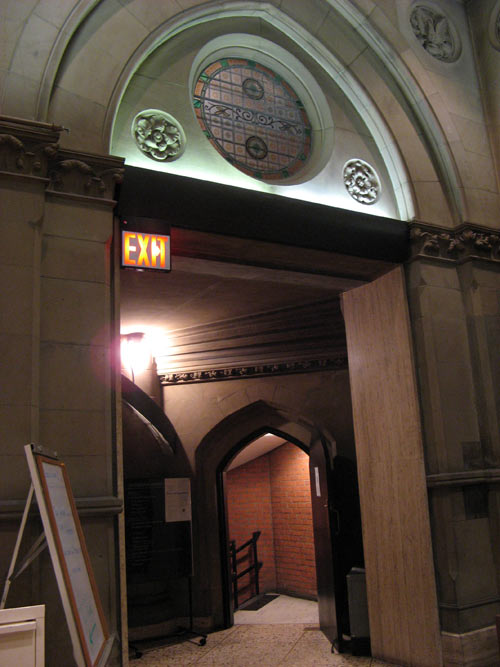
The Jefferson Market clocktower is a regular site on the annual openhousenewyork tour, where the public is invited to climb the 149 steps to the top for 360-degree views of Greenwich Village.
Afterwards, I met SYB a few blocks away at Peanut Butter and Co. on this, the last day to cash in our coupons for jars of peanut butter, which we’d collected at the Time Out “Back to School” festival in Union Square in September. Finally!
I got The Elvis, without the bacon, just like it’s served down in Graceland. I picked up my jar of “The Heat is On”: PB & Co’s “all natural peanut butter blended with fiery spices,” and was even comped my glass bottle of Diet Coke by the friendly cashier. It’s good to be back.
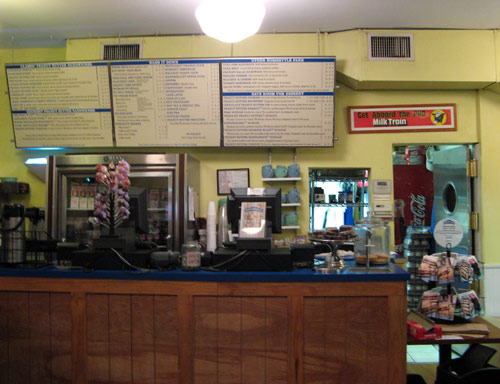

Scenes from the City
Filmmaking in New York was the topic at this book talk, slide show and discussion at the Museum of the City of New York.
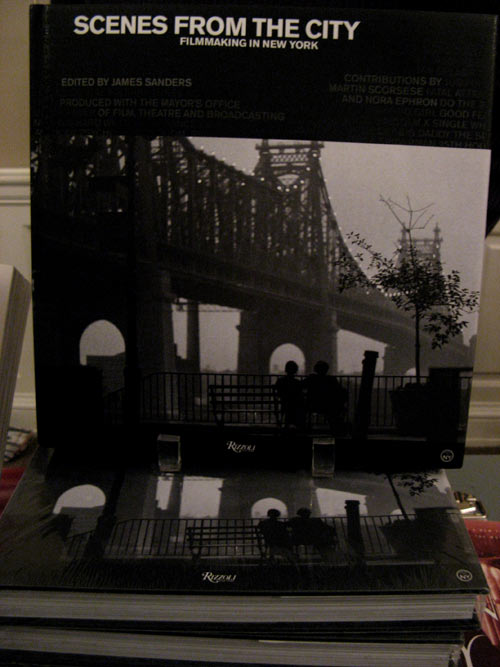
Commissioner Katherine Oliver of the Mayor’s Office of Film, Theatre, and Broadcasting began the presentation, offering an overview of the 40-year history of the MOFTB. Last year, New York City hosted the highest number of film, television, commercial and music video shoots ever: 34,718 shooting days, up from 31,570 in 2005, and 23,321 shooting days in 2004. The city’s movie industry now employs 100,000 New Yorkers, and by the office’s calculations, brings in about $5 billion to the city’s economy every year.
Up next, a slide show presentation by James Sanders, architect and co-writer of the Emmy Award-winning PBS series New York: A Documentary Film (the DVD set of which I received for my birthday last year, compliments of J & J), its companion volume, New York: An Illustrated History, as well as Celluloid Skyline: New York and the Movies (another present, this one from DH. Do my friends and family know me, or what?) Sanders’s new book Scenes from the City: Filmmaking in New York traces the evolution of filming in the city over four decades, contrasting the pristine New York of the Hollywood studio (Rear Window) with the gritty (Mean Streets, Do the Right Thing) and glittering (Breakfast at Tiffany’s, When Harry Met Sally, and so many others) New York of location shooting.
Some fantastic photographs, taken from movie sets, behind the scenes, or on the streets during shooting. Like Celluloid Skyline, there were rare and unusual production stills, taken from studio archives and private collections around the country.
Afterwards, a talk with Rob Striem (on left, below), location manger on several recent “Made in NY” films, the MOFTB program which awards filmmakers a 15% tax break — 5% from the city and another 10% from the state — for projects where at least 75% of the overall production was made in New York City. Streim is currently co-location manager for Warner Brothers Pictures’s I Am Legend, a big budget, sci-fi thriller starring Will Smith, which famously took over the Brooklyn Bridge late last month.
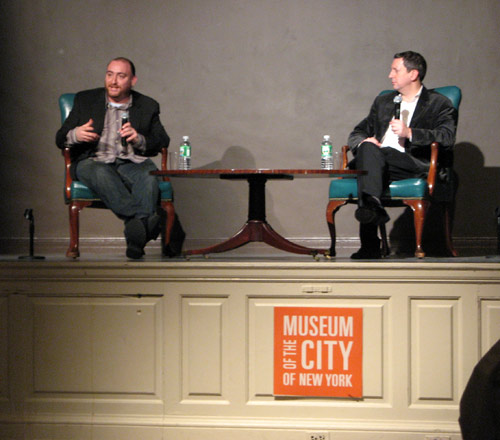
Upstairs, a glimpse of the MCNY galleries.
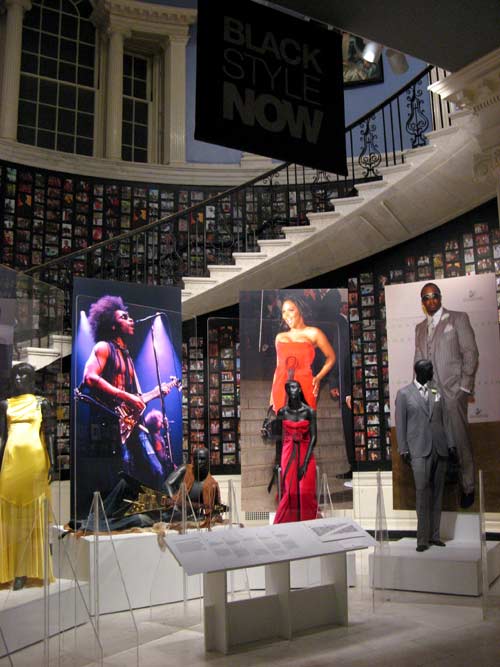
Super Bowl Sunday 2007
At the Public Theater for this month’s installment of 365 Days, 365 Plays — the yearlong, nationwide staging of works by Suzan-Lori Parks, who wrote one play a day from Nov. 13, 2002 to Nov. 12, 2003. (Hence the festival’s title.) Beginning November 13, 2006, nearly 700 theaters in more than 30 cities around the country began presenting Park’s plays. The drama experiment was the subject of features on both NPR and PBS.
Parks is the author of nine full-length plays, including Topdog/Underdog for which, in 2002, she became the first black woman to win the Pulitzer Prize for Drama. She is also the recipient of a MacArthur Fellowship genius grant.
I had missed out on the last two installments, so this time around I made sure to arrive at the theater early enough to secure a seat. No problem at all: the bone-chilling cold seemed to have kept many people at home that afternoon… plus there was that whole “Super Bowl” thing going on…
The 365 plays are distributed among theater companies in one week batches; the selected groups produce their own seven-play assignments, and the first Sunday of every month through mid-November 2007, the Public hosts a show in which each of the previous four weeks’ worth of plays are presented in one sitting.
So this afternoon, I sat back to take in 29 plays over two hours — Parks wrote two for Groundhog Day, naturally. The pieces varied widely in length and in subject; so too did the staging concepts by the 4 (of 65 participating) New York City theater groups: The New Group, Clubbed Thumb, Ars Nova and Barrow Street Theatre. Some scripts featured just two characters, others entire companies; some were acted out on a barren stage, others featured elaborate AV props and musical numbers; some pieces seemed date-specific, others were set in the distant past, or in an alternate reality.
Astor Place at dusk, the site of an 1849 riot in which 22 people were killed outside the old Astor Place Opera House after a performance of Macbeth — the result of an ongoing thespian quarrel that catalyzed latent class tensions in 19th century Manhattan.
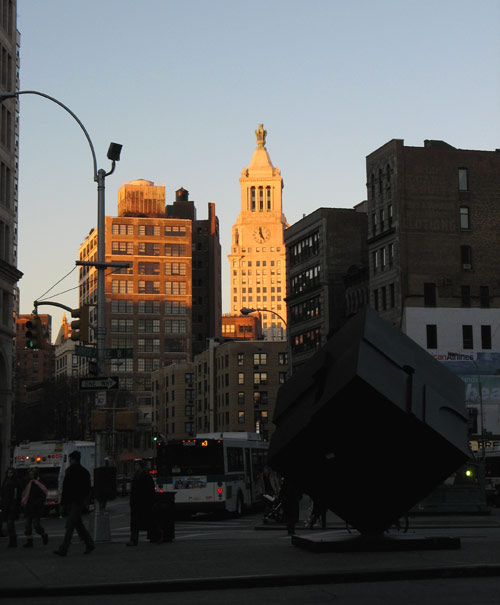
And then the long ride out to Queens for SYB’s party. Super Bowl XLI — that’s 41 for the roman-numerically challenged — Colts vs. Bears.
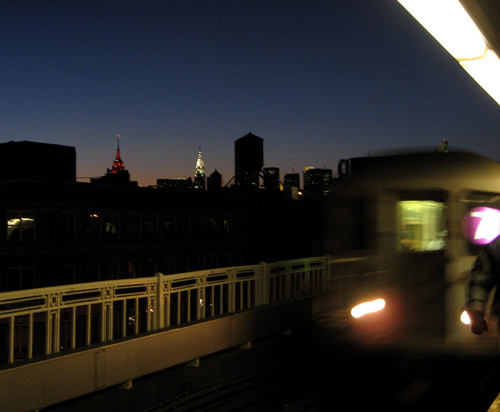
I made it to Sunnyside in time to hear Billy Joel sing the national anthem, after which I caught up with the newlyweds over cassoulet and brie. Made it through two quarters just to catch Prince’s halftime show, which was awesome, though I didn’t quite understand the random assortment of covers: Creedence Clearwater Revival, Bob Dylan and the Foo Fighters (?!) But The Artist can still shred a mean guitar, and by “Purple Rain” — in the rain! – I was glad I stuck it out, phallic shadow show or no.
Oh, the drama.
| S | M | T | W | T | F | S |
|---|---|---|---|---|---|---|
| 1 | ||||||
| 2 | 3 | 4 | 5 | 6 | 7 | 8 |
| 9 | 10 | 11 | 12 | 13 | 14 | 15 |
| 16 | 17 | 18 | 19 | 20 | 21 | 22 |
| 23 | 24 | 25 | 26 | 27 | 28 | 29 |
| 30 | 31 | |||||
Search
Popular Tags
Categories
Archive
- July 2010
- July 2009
- January 2009
- November 2008
- September 2008
- August 2008
- July 2008
- June 2008
- May 2008
- April 2008
- March 2008
- February 2008
- January 2008
- December 2007
- November 2007
- October 2007
- September 2007
- August 2007
- July 2007
- June 2007
- May 2007
- April 2007
- March 2007
- February 2007
- January 2007
- December 2006
- November 2006
- October 2006
- September 2006
- August 2006
- July 2006
- June 2006